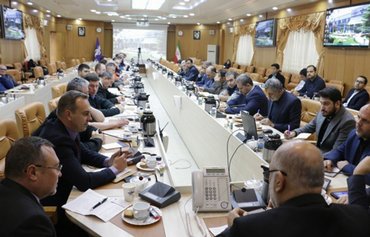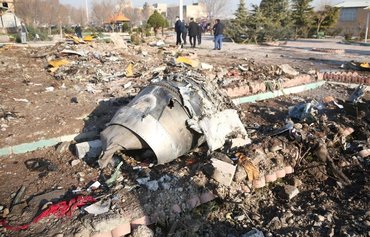Tehran on Friday (January 10th) faced mounting international pressure to allow a "credible" investigation into the crash of a Ukrainian airliner in Iran, which Britain, Canada and the Netherlands suggested was caused by an accidental missile strike.
The Boeing 737 crashed a few minutes after it took off from Tehran's Imam Khomeini airport on Wednesday, killing all 176 on board.
The majority of the passengers on Ukraine International Airlines Flight PS752 were dual national Iranian-Canadians but they also included Ukrainians, Afghans, Britons and Swedes.
The crash came shortly after Tehran launched missiles at US forces in Iraq in response to the killing of Islamic Revolutionary Guard Corps Quds Force commander Qassem Soleimani in a US drone strike in Baghdad.
![People and rescue teams are pictured amid bodies and debris after a Ukrainian plane carrying 176 passengers crashed near Imam Khomeini airport in the Iranian capital Tehran early in the morning on January 8th, killing everyone on board. [Rouhollah Vahdati/ISNA/AFP]](/cnmi_am/images/2020/01/10/21908-Ukrain-plane-crash-600_384.jpg)
People and rescue teams are pictured amid bodies and debris after a Ukrainian plane carrying 176 passengers crashed near Imam Khomeini airport in the Iranian capital Tehran early in the morning on January 8th, killing everyone on board. [Rouhollah Vahdati/ISNA/AFP]
Canadian Prime Minister Justin Trudeau said Thursday that multiple intelligence sources indicated that an Iranian surface-to-air missile downed the plane.
"We know this may have been unintentional. Canadians have questions, and they deserve answers," Trudeau said.
Iran's civil aviation chief Ali Abedzadeh has rejected the allegation.
Trudeau's comments came as video footage emerged that appeared to show the moment the airliner was hit.
The footage, which the New York Times said it had verified, shows a fast-moving object rising at an angle into the sky before a bright flash is seen, which dims and continues moving forward. Several seconds later an explosion is heard.
Dutch intelligence has information that the airliner was probably hit by a missile, defence minister Ank Bijleveld said Friday.
"Based on the information from the MIVD (Dutch military intelligence), we can state that it is likely that an Iranian anti-aircraft missile has led to the crash of the aircraft," Bijleveld was quoted as saying by a spokesman.
Bijleveld gave no further details of the information or how the Netherlands, which did not have any nationals on board the flight, obtained it.
NATO chief Jens Stoltenberg said Friday he had no reason to doubt reports from Western capitals suggesting an Iranian missile brought down the airliner.
"I will not go into details about our intelligence but what I can say is we have no reason to not believe the reports we have seen from different NATO allied capitals," Stoltenberg said.
'Important data'
Ukrainian Foreign Minister Vadym Prystaiko said US officials have handed Kiev "important data" following the crash.
Tehran's foreign ministry said that a Canadian delegation was en route to Iran to "handle the affairs of the Canadian victims", a rarity since the two countries cut diplomatic relations in 2012.
Canada's transportation safety board on Thursday confirmed it had accepted an invitation from Iran's civil aviation authority to join the inquiry.
Iran's civil aviation chief said Tehran had invited "Americans, Canadians, the French, Ukrainians and the Swedish" to be present during the investigations.
The US National Transportation Safety Board said late Thursday it had received formal notification of the crash from Iran and would send a representative to join the investigation.
Iran's foreign ministry earlier invited US plane maker Boeing to "participate" in the probe.
France is the co-manufacturer of the plane's engines, and has offered its expertise because it is one of the few countries able to comprehensively decipher black box data.
'Full, transparent investigation'
The EU has demanded an "independent and credible" probe into the crash.
British Prime Minister Boris Johnson called for a full, transparent investigation, saying that mounting evidence supported a missile strike, which "may well have been unintentional".
Ukraine called for UN support for a broad investigation, and sent 45 crash investigators to Tehran to take part in the inquiry led by Iranian authorities.
Ukraine's national security and defence council secretary Oleksiy Danilov said investigators were pursuing several leads.
These include a possible strike with a surface-to-air missile such as a Russian-made Tor, a collision with a drone, engine failure or a terror attack, he said.
US President Donald Trump indicated that Washington officials believed the Kiev-bound Boeing 737 was struck by one or more Iranian missiles.
Unidentified officials told US media that satellite, radar and electronic data indicated Tehran's air defence units downed the aircraft.
But Iran's aviation authority chief said the missile theory could not be "scientifically correct" because it was not possible for an airliner to be hit and "continue flying for 60 to 70 seconds".
And "the debris collected has been in a very limited area. If there was an explosion in the wings it should have been much more scattered", Abedzadeh added, noting that analysing the black box data "will take time".
The airliner went down in the dark just minutes after takeoff, with no radio message from the pilot to indicate distress, according to the Iranian aviation authorities.
The pilot did not call the tower because "he must have been trying to save the airplane before anything else", Abedzadeh said.
Regional experts react
A security expert at a Middle Eastern research centre told Al-Mashareq the Iranian authorities ought to be transparent in relation to the current investigations.
Senior expert and consultant at the Royal Jordanian Aviation Academy Hazem al-Abadaleh pointed to the stricken plane's safety record, the extensive experience of its crew and the circumstances of the crash, noting that the crash coincided with Iranian military air activity.
"The European Aviation Safety Agency, the UN-affiliated International Civil Aviation Organisation and inspectors dispatched by the Ukrainian authorities or any country that had citizens among the victims of the stricken plane must be given unimpeded access and allowed to ascertain the truth," he said.
"From a technical standpoint, the plane should not have fallen so quickly, considering that its climb after take-off was normal and stable," he said.
"The dispersion of the debris and the way it fell are all reasons for concern that the plane may have come under some kind of attack," he added.
'Shrouded in secrecy'
Al-Sharq Centre for Security and Strategic Studies researcher and security expert Ahmad al-Hamdani told Al-Mashareq Iran has so far restricted journalists from reaching the site or speaking with local residents or eyewitnesses.
Al-Hamdani said the Iranians' version of events, that the plane experienced a technical problem, does not seem convincing.
Iran has to "allow investigations to be conducted by the countries of the victims or international aviation organisations, because the theory that the plane was hit by a missile is closer to reality", he said.
"The fact that the Iranian authorities are shrouding the incident with secrecy and placing various restrictions on investigators, journalists and the publishing of information about the incident... reinforces suspicions that the plane was actually hit by a surface-to-air missile," he said.

![A child's shoe is pictured on January 8th at the scene of a Ukrainian airliner that crashed shortly after take-off near Imam Khomeini airport in the Iranian capital Tehran. [Borna Ghassemi/ISNA/AFP]](/cnmi_am/images/2020/01/10/21913-Tehran-child-shoe-600_384.jpg)
![Rescue teams work at the scene after a Ukrainian plane carrying 176 passengers crashed near Imam Khomeini airport in Tehran early in the morning on January 8th, killing everyone on board. [AFP]](/cnmi_am/images/2020/01/10/21919-Rescue-teams-Tehran-600_384.jpg)
![Mourners light candles for the victims of Ukrainian Airlines flight 752 which crashed in Iran during a vigil at Mel Lastman Square in Toronto, Ontario on January 9th. [Geoff Robins/AFP]](/cnmi_am/images/2020/01/10/21916-Toronto-crash-vigil-600_384.jpg)
![A woman holds a sign for one of the victims of Ukrainian Airlines flight 752 which crashed in Iran, during a vigil at Mel Lastman Square in Toronto, Ontario on January 9th. [Geoff Robins/AFP]](/cnmi_am/images/2020/01/10/21914-Woman-Toronto-sign-600_384.jpg)






